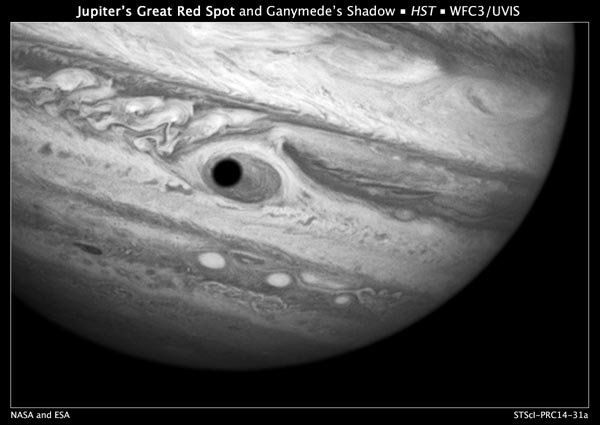Here's Looking At You: Spooky Shadow Play Gives Jupiter a Giant Eye

NASA, ESA, and A. Simon (Goddard Space Flight Center); Acknowledgment: C. Go and the Hubble Heritage Team (STScI/AURA) On Apri1 21, 2014, the Hubble Space Telescope was being used to monitor changes in Jupiter's Great Red Spot (GRS) storm. During the exposures, the shadow of the Jovian moon Ganymede swept across the center of the GRS. This gave the giant planet the uncanny appearance of having a pupil in the center of a 10,000-mile-diameter "eye." Momentarily, Jupiter took on the appearance of a Cyclops planet!
This happened on April 21, 2014, when Hubble was being used to monitor changes in Jupiter's immense Great Red Spot (GRS) storm. During the exposures, the shadow of the Jovian moon Ganymede swept across the center of the GRS. This gave the giant planet the uncanny appearance of having a pupil in the center of a 10,000-mile-diameter “eye.” Momentarily, Jupiter took on the appearance of a Cyclops planet!
Credit: NASA, ESA, and A. Simon (Goddard Space Flight Center)
Acknowledgment: C. Go and the Hubble Heritage Team (STScI/AURA)
For images and more information, visit:
http://hubblesite.org/news/2014/31
http://heritage.stsci.edu/2014/31
For additional information, contact:
Ray Villard
Space Telescope Science Institute, Baltimore, Md.
410-338-4514
villard@stsci.edu
Amy Simon
Goddard Space Flight Center, Greenbelt, Md.
301-286-6738
amy.simon@nasa.gov
The Hubble Space Telescope is a project of international cooperation between NASA and the European Space Agency. NASA's Goddard Space Flight Center in Greenbelt, Md., manages the telescope. The Space Telescope Science Institute (STScI) in Baltimore, Maryland, conducts Hubble science operations. STScI is operated for NASA by the Association of Universities for Research in Astronomy, Inc., in Washington, D.C.
Media Contact
More Information:
http://www.nasa.govAll latest news from the category: Physics and Astronomy
This area deals with the fundamental laws and building blocks of nature and how they interact, the properties and the behavior of matter, and research into space and time and their structures.
innovations-report provides in-depth reports and articles on subjects such as astrophysics, laser technologies, nuclear, quantum, particle and solid-state physics, nanotechnologies, planetary research and findings (Mars, Venus) and developments related to the Hubble Telescope.
Newest articles

A universal framework for spatial biology
SpatialData is a freely accessible tool to unify and integrate data from different omics technologies accounting for spatial information, which can provide holistic insights into health and disease. Biological processes…

How complex biological processes arise
A $20 million grant from the U.S. National Science Foundation (NSF) will support the establishment and operation of the National Synthesis Center for Emergence in the Molecular and Cellular Sciences (NCEMS) at…

Airborne single-photon lidar system achieves high-resolution 3D imaging
Compact, low-power system opens doors for photon-efficient drone and satellite-based environmental monitoring and mapping. Researchers have developed a compact and lightweight single-photon airborne lidar system that can acquire high-resolution 3D…





















